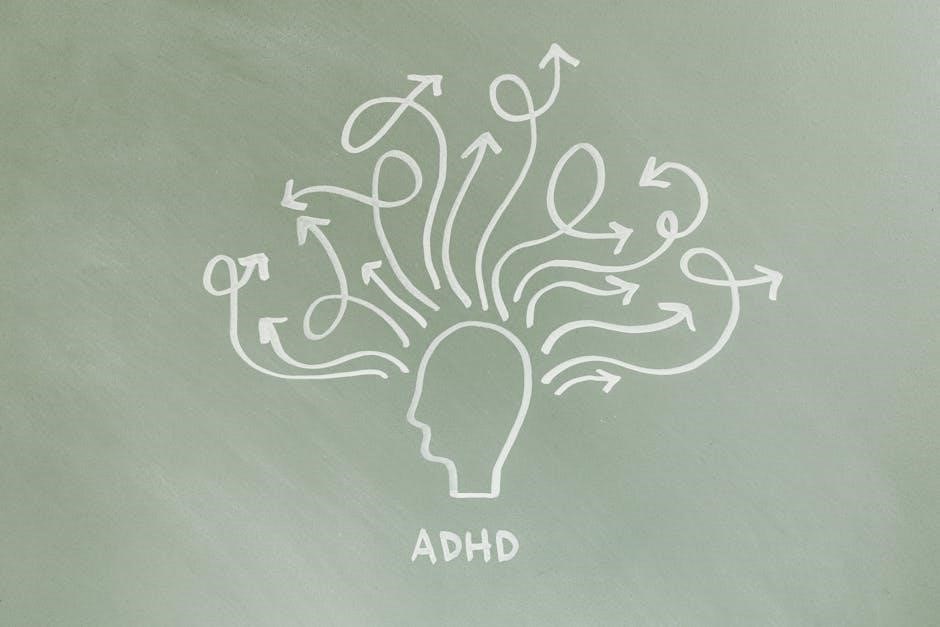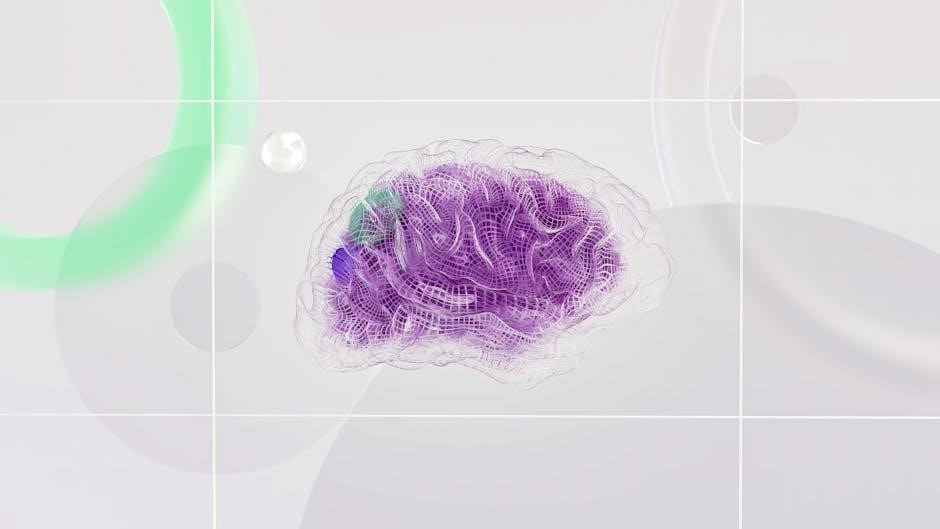bullet in the brain pdf
Tobias Wolff’s “Bullet in the Brain” is a gripping short story about a book critic caught in a robbery. Available as a PDF, it explores themes of pessimism, nostalgia, and redemption through Anders’ tragic fate;
Background Information
“Bullet in the Brain” is a short story by Tobias Wolff, first published in 1995. It is part of his collection The Night in Question. The story revolves around Anders, a cynical book critic, who becomes an unintended victim in a bank robbery. The narrative explores themes of pessimism, nostalgia, and the fleeting nature of human connection. The story is known for its vivid imagery and psychological depth, particularly in its depiction of Anders’ final moments. Available as a PDF, the story has been widely studied for its literary significance and emotional impact. Wolff’s concise yet powerful prose makes it a standout piece in his body of work, offering readers a haunting reflection on life and mortality.
Availability as a PDF
Tobias Wolff’s “Bullet in the Brain” is widely available as a PDF for easy access to readers and scholars. The story can be downloaded from various online platforms, including academic databases and literary websites. Some versions are free, while others may require purchase or subscription. The PDF format allows readers to study the narrative’s structure, themes, and language in depth. It is often included in anthologies or standalone publications, making it a convenient resource for educational purposes. The story’s popularity as a PDF underscores its relevance in literary studies and its enduring appeal to readers interested in contemporary fiction and psychological exploration.

Plot Summary
The story recounts Anders, a cynical book critic, caught in a robbery. His laughter at a robber’s phrase leads to his fatal shooting, triggering nostalgic memories.
Key Events Leading to the Shooting
The story begins with Anders, a cynical book critic, witnessing a robbery at a bank. His sarcastic remarks annoy one of the robbers, escalating tensions. Anders’ dismissive attitude and laughter at the robber’s phrase, “Capeesh,” provoke the robber, who then shoots him in the head. The bullet enters Anders’ brain, slowing down time in his mind. This moment triggers a vivid flashback to a childhood baseball game, highlighting a rare moment of joy and innocence in Anders’ life. The robbery’s chaos and Anders’ fatal reaction set the stage for exploring themes of regret, nostalgia, and the fleeting nature of redemption.
The Climax: Anders’s Death
Anders’ death serves as the story’s emotional peak. The bullet’s slow journey through his brain allows him to relive a cherished childhood memory, contrasting sharply with his cynical present. This moment of nostalgia underscores the themes of lost innocence and the redemptive power of memory. The climax highlights Wolff’s mastery of narrative structure, blending the brutality of the shooting with the poignancy of Anders’ inner reflection. His death symbolizes the tragic consequences of his pessimistic outlook, leaving readers to ponder the what-ifs of his life. The scene is both haunting and profound, leaving a lasting impression on the reader.

Major Themes
The story explores themes of pessimism, nostalgia, and redemption. Anders’ cynical outlook contrasts with fleeting memories of joy, highlighting the complexity of human emotion and the inevitability of fate.
The Power of Pessimism
Anders’ pervasive pessimism shapes his worldview, coloring every interaction with cynicism. His career as a book critic has hardened him, fostering a deep distrust in literature and life. This outlook alienates him from others, as his sharp tongue and disdain for sentimentality create barriers. Even in the face of death, Anders’ cynicism remains unyielding, reflecting a lifelong embrace of fatalism; His final moments, filled with mockery and defiance, underscore the enduring power of his pessimistic nature. Wolff uses Anders’ character to explore how a lifetime of negativity can define one’s existence, ultimately leading to a tragic, yet fitting, conclusion. The story highlights the destructive potential of unchecked cynicism and its impact on the human spirit.
Nostalgia and Lost Innocence
Anders’ final moments reveal a profound sense of nostalgia as memories of his past flood his mind. A childhood baseball game emerges, symbolizing a time of simplicity and joy. This flashback contrasts sharply with his cynical adulthood, highlighting the loss of innocence that defined his life. The memory of repeating the word “capeesh” as a boy underscores a carefree era, far removed from his later pessimism. Wolff uses this nostalgic scene to illustrate how fleeting happiness can be, and how easily it can be overshadowed by the complexities and disillusionments of adulthood. The story suggests that even in death, the past holds the power to evoke deep emotional resonance, offering a poignant reflection on what has been lost.

Character Analysis
Anders, a cynical book critic, embodies pessimism and bitterness, while the robbers symbolize violence and intimidation, driving the story’s tension and tragic outcome through their interactions.
Anders: The Cynical Book Critic
Anders, the protagonist of “Bullet in the Brain,” is a cynical and pessimistic book critic whose outlook on life is deeply influenced by his career. His profession has made him overly critical, not just of literature but of the world around him. This cynicism isolates him, making it difficult for him to connect with others or find meaning in his experiences. During the robbery, Anders’s laughter at the absurdity of the situation triggers the fatal shot, showcasing his inability to take things seriously even in life-threatening circumstances. His memories, which surface as the bullet travels through his brain, reveal a deeper, more vulnerable side to his personality, contrasting sharply with his hardened exterior. Through Anders, Wolff explores the consequences of a life steeped in negativity and lost opportunities for connection.
The Robbers: Symbols of Violence
The robbers in “Bullet in the Brain” serve as catalysts for the story’s tragic events and emblematic figures of violence. Their sudden appearance in the bank disrupts the mundane atmosphere, introducing an air of tension and unpredictability. The robbers’ aggressive demeanor and menacing questions highlight their dangerous nature, while their demand for silence and control underscores their intent to dominate. Anders’s laughter at their absurdity provokes the fatal shot, illustrating how their violence is both explosive and senseless. Through their actions, Wolff portrays the robbers as symbols of societal chaos and the random nature of violence. They also contrast sharply with Anders’s intellectual yet emotionally detached worldview, emphasizing the harsh realities of a world where brutality can interrupt even the most ordinary lives. The robbers’ presence drives the narrative toward its devastating climax, leaving a lasting impact on the story’s themes and tone.

Symbolism
The bullet symbolizes fate and inevitability, while Anders’s memories represent redemption. The slow journey of the bullet through his brain contrasts with the swift synaptic activity, emphasizing the themes of time and reflection.
Anders’s forgotten memories, triggered by the bullet, symbolize lost innocence and the power of nostalgia. The bullet’s path through his brain serves as a metaphor for life’s unpredictability and finality.
The Bullet as a Symbol of Fate
The bullet in Anders’s brain symbolizes the inevitability of fate, moving at a glacial pace compared to the rapid synaptic activity it disrupts. This contrast underscores the themes of time and reflection, allowing Anders to relive forgotten memories and confront his life choices.
The bullet’s journey represents the irreversible nature of destiny, as Anders’s thoughts unfold in slow motion. It serves as a metaphor for life’s unpredictability, highlighting how a single event can alter the course of existence, leaving no room for escape or redemption.
Anders’s Memories as a Symbol of Redemption
Anders’s memories, triggered by the bullet’s slow journey through his brain, serve as a poignant symbol of redemption. These fleeting recollections, particularly of a childhood baseball game, reveal a longing for lost innocence and connection. The memories contrast sharply with his cynical, isolated adult life, suggesting a desire for reconciliation with his past. Through these flashes, Wolff highlights the human capacity for reflection and the possibility of finding meaning even in life’s final moments. Anders’s memories thus offer a glimmer of redemption, reminding readers of the enduring power of personal history and the universal quest for forgiveness and understanding.

Literary Style and Structure
Tobias Wolff employs a unique narrative technique, blending vivid descriptions with psychological depth. The story’s structure, divided into two parts, masterfully uses flashbacks to explore Anders’s past and redemption.
Wolff’s Narrative Technique
Tobias Wolff’s narrative technique in “Bullet in the Brain” is masterful, blending psychological depth with vivid imagery. He uses a third-person limited perspective to immerse readers in Anders’s consciousness. The story’s non-linear structure, enriched by flashbacks, reveals Anders’s past, creating emotional resonance. Wolff’s prose is both concise and evocative, capturing the surreal slowing of time as the bullet traverses Anders’s brain. This technique allows Anders—and the reader—to reflect on forgotten memories, juxtaposing violence with nostalgia. Wolff’s ability to balance the grim reality of the robbery with the poetic quality of Anders’s recollections underscores his storytelling prowess, making the tale both haunting and deeply human. His style ensures the narrative is as thought-provoking as it is engrossing.
Use of Flashbacks
Tobias Wolff employs flashbacks in “Bullet in the Brain” to delve into Anders’s past, revealing forgotten memories as the bullet traverses his brain. These flashbacks are triggered by the slowing of time, allowing Anders to reflect on moments he had suppressed. A pivotal memory is his childhood baseball game, where he repeats the phrase “I could field the Viola boys’ grounder,” symbolizing lost innocence. The flashbacks contrast the violence of the robbery with Anders’s nostalgic recollections, emphasizing themes of regret and redemption. Wolff’s use of this technique creates emotional depth, offering insight into Anders’s character while highlighting the fleeting nature of memory. The flashbacks also serve as a counterpoint to the brutality of the present, enriching the narrative’s complexity. This storytelling device is both poignant and powerful, leaving a lasting impression on readers.

Historical and Cultural Context
Tobias Wolff’s “Bullet in the Brain” reflects its 1995 publication, part of “The Night in Question” collection, set in a contemporary urban context, exploring societal issues of the time.
The Setting of the Story
The story unfolds in a contemporary urban setting, likely during the evening, as Anders is caught in a bank robbery. The tense atmosphere of the crime scene contrasts with Anders’ nostalgic flashbacks to a suburban baseball field, symbolizing lost innocence. The setting shifts between the bleak reality of the robbery and the idyllic memories of Anders’ childhood, highlighting the disparity between his cynical present and his once joyful past. This juxtaposition underscores the themes of nostalgia and redemption, central to the narrative. The urban backdrop emphasizes the randomness and violence of the event, while the suburban memories evoke a sense of simplicity and happiness that Anders has lost.
Societal Commentary
The story serves as a poignant commentary on societal violence and the disillusionment of modern life. The robbers’ actions reflect a broader frustration with societal norms, as they lash out when disrespected, mirroring tensions in urban environments. Anders’ cynicism toward literature and life symbolizes the alienation of intellectuals in a materialistic world. The narrative critiques the randomness of violence and its impact on individuals, highlighting how societal failures can lead to tragic consequences. Wolff’s portrayal of Anders’ lost innocence underscores the erosion of hope in contemporary society. The story provokes reflection on how societal pressures shape individual destinies and the inevitability of violence in a fractured world.

Critical Reception
“Bullet in the Brain” has received acclaim for its hauntingly beautiful prose and profound exploration of human frailty. Critics praise Wolff’s ability to blend tragedy with introspection, though some find the narrative emotionally distant. The story’s unique structure and thematic depth have solidified its place in literary discussions, making it a frequently studied work in academic settings. Its exploration of pessimism and nostalgia resonates deeply, leaving readers with a lasting impression of the human condition. The critical consensus highlights Wolff’s mastery of storytelling, though opinions on Anders’ likability vary, adding to the story’s complexity and debate.
Reviews and Analysis
Tobias Wolff’s “Bullet in the Brain” has garnered widespread critical acclaim for its masterful storytelling and emotional depth. Reviewers highlight the story’s ability to juxtapose violence with introspection, creating a hauntingly beautiful narrative. Anders, the cynical book critic, is often praised as a complex character whose transformation during his final moments captivates readers. Critics note how Wolff’s use of flashbacks humanizes Anders, revealing a man torn between his pessimistic outlook and forgotten moments of joy. The story’s exploration of nostalgia and redemption is particularly praised, offering a poignant reflection on life’s fleeting nature. While some critics find the tone emotionally detached, most agree that Wolff’s prose is evocative and thought-provoking, making “Bullet in the Brain” a standout piece in contemporary literature.
Comparison to Other Works
Tobias Wolff’s “Bullet in the Brain” draws comparisons to Ernest Hemingway’s “The Killers,” both featuring violent encounters between criminals and bystanders. Like Hemingway, Wolff crafts tense, atmospheric scenes that explore human psychology under duress. However, Wolff’s narrative delves deeper into introspection, particularly through Anders’ memories, offering a more emotional and reflective tone. The story also echoes themes found in Raymond Carver’s work, where ordinary lives intersect with sudden, transformative events. Yet, Wolff’s unique voice sets “Bullet in the Brain” apart, blending cynicism with poignancy in a way that resonates distinctly. This blend of influences and originality makes the story a compelling addition to the literary canon of concise, impactful storytelling.

Educational Significance
“Bullet in the Brain” is often studied in academic settings for its literary techniques, themes, and character development, making it a valuable resource for teaching critical analysis.
Use in Academic Curricula
Tobias Wolff’s “Bullet in the Brain” is frequently included in academic syllabi for its rich thematic depth and literary craftsmanship. The story’s exploration of pessimism, nostalgia, and violence makes it a compelling text for studying narrative structure and character development. Educators often use the PDF version of the story to facilitate classroom discussions, as it provides easy access to the material. The tale’s concise yet impactful nature allows instructors to delve into themes such as the consequences of cynicism and the power of memory. Additionally, its relatable protagonist and vivid imagery make it an excellent choice for teaching critical thinking and analytical skills. As a result, “Bullet in the Brain” remains a popular and educational resource in high schools and universities worldwide.
Discussion Topics
Tobias Wolff’s “Bullet in the Brain” offers numerous discussion topics, such as the theme of pessimism and its impact on Anders’ life, the role of nostalgia in shaping his final moments, and the symbolism of the bullet as fate. Students can explore how Anders’ cynicism reflects his inner turmoil and how his memories reveal a longing for lost innocence. The story also invites analysis of its narrative structure, particularly the use of slow motion to emphasize the significance of Anders’ recollections. Additionally, the portrayal of violence and its consequences can lead to discussions on societal issues. The PDF version of the story facilitates easy access for classroom analysis, making it a valuable tool for exploring themes, character development, and literary techniques. These elements make “Bullet in the Brain” a rich text for academic exploration.
Tobias Wolff’s “Bullet in the Brain” leaves a lasting impact, blending tragedy with introspection. Anders’ death and memories highlight themes of pessimism and lost innocence, making the PDF a poignant read.

Final Thoughts
Tobias Wolff’s Bullet in the Brain is a profound exploration of human frailty and redemption. The story masterfully blends tragedy with introspection, as Anders’ final moments reveal the depth of his inner world. The bullet, a symbol of inevitability, triggers a flood of memories that highlight his lost innocence and the power of nostalgia. Wolff’s narrative technique, particularly the use of flashbacks, creates a vivid contrast between the slowness of the bullet’s path and the rapidity of Anders’ recollections. This duality underscores the story’s themes of pessimism and the enduring impact of past experiences. The PDF version of the story remains a compelling resource for readers, offering a poignant reflection on life, death, and the human condition.
Lasting Impact
Bullet in the Brain leaves a lasting impression with its haunting exploration of life’s fragility and the power of memory. The story’s vivid imagery and emotional depth ensure its resonance long after reading. The bullet’s slow traversal of Anders’ brain serves as a poignant metaphor for the inevitability of fate and the fleeting nature of human existence. Wolff’s masterful storytelling highlights the transformative power of nostalgia, as Anders’ final memories reveal a longing for connection and lost innocence. The PDF version of the story continues to captivate readers, offering a stark reminder of life’s unpredictability and the enduring influence of past experiences. Its themes of regret and redemption remain timeless, making it a significant work in contemporary literature.